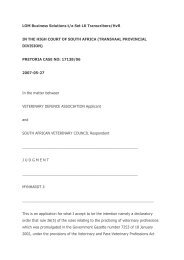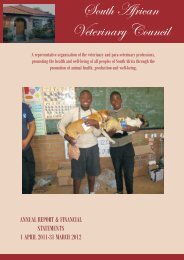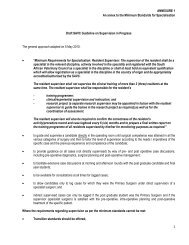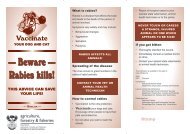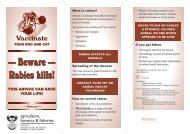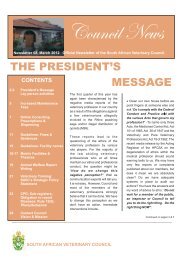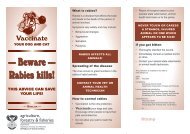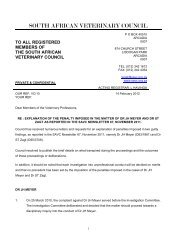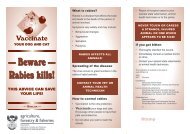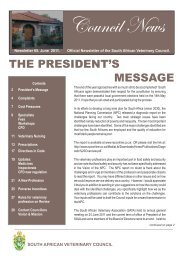Rabies Guide 2010.pdf - the South African Veterinary Council
Rabies Guide 2010.pdf - the South African Veterinary Council
Rabies Guide 2010.pdf - the South African Veterinary Council
You also want an ePaper? Increase the reach of your titles
YUMPU automatically turns print PDFs into web optimized ePapers that Google loves.
Table 1: Cases of rabies-related viruses in <strong>South</strong> Africa<br />
Location Year Host Virus<br />
Pinetown and Durban, KZN 12 1980 Fruit bats (Epomophorus wahlbergi)# Lagos bat<br />
Stanger, KZN 13 1982 Cat Lagos bat<br />
Durban, KZN 14 1990 Fruit bat (E. wahlbergi) Lagos bat<br />
Durban, KZN 182 2003 Fruit bat (E. wahlbergi) Lagos bat<br />
Richards Bay, KZN 185 2003 Canine Lagos bat<br />
Durban, KZN 182 2004 Fruit bat (E. wahlbergi) Lagos bat<br />
Durban, KZN 175 2004 Water mongoose Lagos bat<br />
Durban, KZN 182 2005 Fruit bat (E. wahlbergi) Lagos bat<br />
Durban, KZN 182 2006 Fruit bat (E. wahlbergi) Lagos bat<br />
Durban, KZN** 2008 Fruit bat (E. wahlbergi) Lagos bat<br />
Bela-Bela, Limpopo 15 1970 Human Duvenhage<br />
Louis Trichardt, Limpopo 12 1981 Insectivorous bat Duvenhage<br />
Near Rustenburg, North West 160 2006 Human Duvenhage<br />
Umhlanga Rocks, KZN 12 1970 Cat Mokola<br />
Mdantsane, Eastern Cape 17 1995 Cat Mokola<br />
East London, Eastern Cape 16 1996 Cat Mokola<br />
Yellow Sands, Eastern Cape 17 1996 Cat Mokola<br />
Pinetown, KZN 17 1997 Cat Mokola<br />
Pinetown, KZN 17 1997 Cat Mokola<br />
Pietermaritzburg, KZN 17 1998 Cat Mokola<br />
Nkomazi, Mpumalanga 171 2005 Dog Mokola<br />
East London, Eastern Cape 171 2006 Cat Mokola<br />
Stonehills, Eastern Cape*** 2008 Cat Mokola<br />
<br />
* KZN = KwaZulu-Natal<br />
** Personal communication: Dr W Markotter, University of Pretoria<br />
*** Personal communication: Dr C Sabeta, Agriculature Research <strong>Council</strong>, Onderstepoort <strong>Veterinary</strong> Institute<br />
# Thirteen fruit bats tested positive with <strong>the</strong> fluorescent antibody test but only three virus isolates were obtained<br />
In February 1970, an adult male patient from Bela-<br />
Bela (formerly Warmbaths), approximately 100 km<br />
north of Pretoria, died after a five day illness, which was<br />
diagnosed clinically as rabies. Infection was thought to<br />
have taken place following a bite on <strong>the</strong> lip from a bat,<br />
thought to be an insectivorous species. 15 This index<br />
virus was subsequently typed as Duvenhage virus and<br />
a fur<strong>the</strong>r isolation has subsequently been made from a<br />
bat in <strong>South</strong> Africa during 1981. 12 In 2006 a patient<br />
died of rabies after an encounter with a bat in <strong>the</strong><br />
North West province in <strong>South</strong> Africa. The etiological<br />
agent was confirmed to be Duvenhage virus. The<br />
exposure occurred about 80 km from where <strong>the</strong> first<br />
exposure occurred 36 years earlier. 160 The first reported<br />
case of Duvenhage virus infection outside of Sou<strong>the</strong>rn<br />
Africa was confirmed in 2007. A Dutch tourist was<br />
scratched by what was thought to be an insectivorous<br />
bat at a camping site in Kenya. She developed signs of<br />
rabies about 3 weeks after <strong>the</strong> exposure and died in a<br />
hospital in Amsterdam 23 days later. 176<br />
<strong>Rabies</strong> virus is antigenically most closely related to <strong>the</strong><br />
Australian bat Lyssavirus and most distant from Lagos<br />
bat virus, Mokola virus and West Caucasian bat virus<br />
(a newly described lyssavirus), in this order. 8,18,177-179 An<br />
illustration of <strong>the</strong> distant relationship between rabies<br />
virus and <strong>the</strong>se viruses is <strong>the</strong> fact that standard rabies<br />
vaccination as well as post-exposure prophylaxis gives<br />
little to no protection against <strong>the</strong>se viruses. 180-181 In<br />
<strong>the</strong> absence of specific vaccines and immunoglobulins<br />
it is reasonable that standard rabies vaccine and<br />
immunoglobulin be used in all instances of potential<br />
exposure to rabies-related viruses.<br />
Over <strong>the</strong> past 20 years an important development has<br />
been <strong>the</strong> recognition, through monoclonal antibody<br />
and gene sequencing studies, that genotype 1 viruses<br />
which cycle in particular host species and often<br />
within distinct geographic regions, tend to undergo<br />
genetic adaptation resulting in <strong>the</strong> development of<br />
biotypes. 14,19,20 These biotypes, which have subtle



